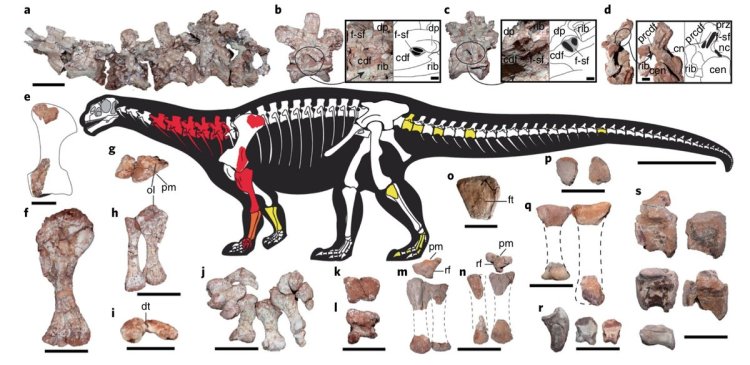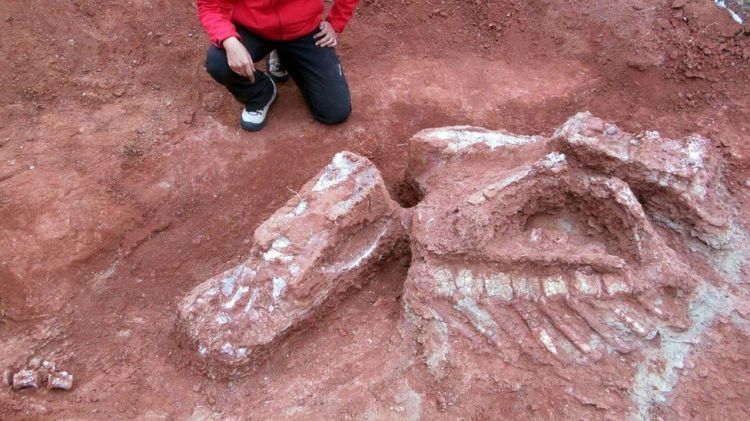
Skeletal anatomy of Ingentia prima (From Apaldetti et al., 2018)
During the Late Triassic period numerous extinctions, diversifications and faunal radiations changed the ecosystem dynamics throughout the world. Followed the extinction of rhynchosaurs in most, or all, parts of the world, there was a burst of dinosaurian diversity in the late Carnian, represented by the upper Ischigualasto Formation and coeval units, with mostly carnivorous small- to medium-sized dinosaurs. Then, the long span of the early Norian, from 228.5–218 Ma, during which dicynodonts and sauropodomorph dinosaurs were the major herbivores.
Sauropods evolved from small, gracile, bipedal forms, and it was long thought that acquisition of giant body size in this clade occurred during the Jurassic and was linked to several skeletal modifications. Ingentia prima — literally the “first giant” in Latin — from the Late Triassic of Argentina shed new lights on the origin of gigantism in this group. The holotype, PVSJ 1086, composed of six articulated posterior cervical vertebrae, glenoid region of right scapula and right forelimb lacking all phalanges, has been recovered from the southern outcrops of the Quebrada del Barro Formation, northwestern Argentina. Discovered in 2015 by Diego Abelín and a team led by Cecilia Apaldetti of CONICET-Universidad Nacional de San Juan, Argentina, this new fossil weighed up to 11 tons and measured up to 32 feet (10 meters) long.

Bones of Ingentia prima (Image credit: Cecilia Apaldetti, CONICET-Universidad Nacional de San Juan, Argentina)
Ingentia was unearthed with three new specimens of Lessemsaurus sauropoides. The four dinosaurs belongs to the clade Lessemsauridae, that differs from all other Sauropodomorpha dinosaurs in possessing robust scapulae with dorsal and ventral ends equally expanded; slit-shaped neural canal of posterior dorsal vertebrae; anterior dorsal neural spines transversely expanded towards the dorsal end; a minimum transverse shaft width of the first metacarpal greater than twice the minimum transverse shaft of the second metacarpal; and bone growth characterized by the presence of thick zones of highly vascularized fibrolamellar bone, within a cyclical growth pattern.
The age of the oldest lessemsaurid (mid-Norian) indicates the appearance of an early trend towards large body size at least 15 Myr earlier than previously thought. For a long time, gigantism in eusauropods has been proposed as the result of a complex interplay of anatomical, physiological and reproductive intrinsic traits. For example, the upright position of the limbs has been highlighted as a major feature of the sauropodomorph bauplan considered an adaptation to gigantism. However Lessemsaurids lacked the purported adaptations related to a fully erect forelimb and the marked modifications of the hindlimb lever arms in eusauropods, showing that these features were not strictly necessary for the acquisition of gigantic body size. Another feature interpreted as a key acquisition was the elongated neck. However, lessemsaurids also lacked an elongated neck as they had proportionately short cervical vertebrae, indicating that the neck elongation was not a prerequisite for achieving body sizes comparable to those of basal eusauropods or gravisaurians.
References:
Cecilia Apaldetti, Ricardo N. Martínez, Ignacio A. Cerda, Diego Pol and Oscar Alcober (2018). An early trend towards gigantism in Triassic sauropodomorph dinosaurs. Nature Ecology & Evolution. https://doi.org/10.1038/s41559-018-0599-y
Pingback: Fossil Friday Roundup: July 20, 2018 | PLOS Paleo Community
Pingback: #97 Jul18. Prueba de bombeo, Megalayense, Helen Tappan, Ingentia prima, polvo marciano, “Geoexperimentos veraniegos” | GeoCastAway
Pingback: A very short history of Dinosaurs. | Letters from Gondwana.